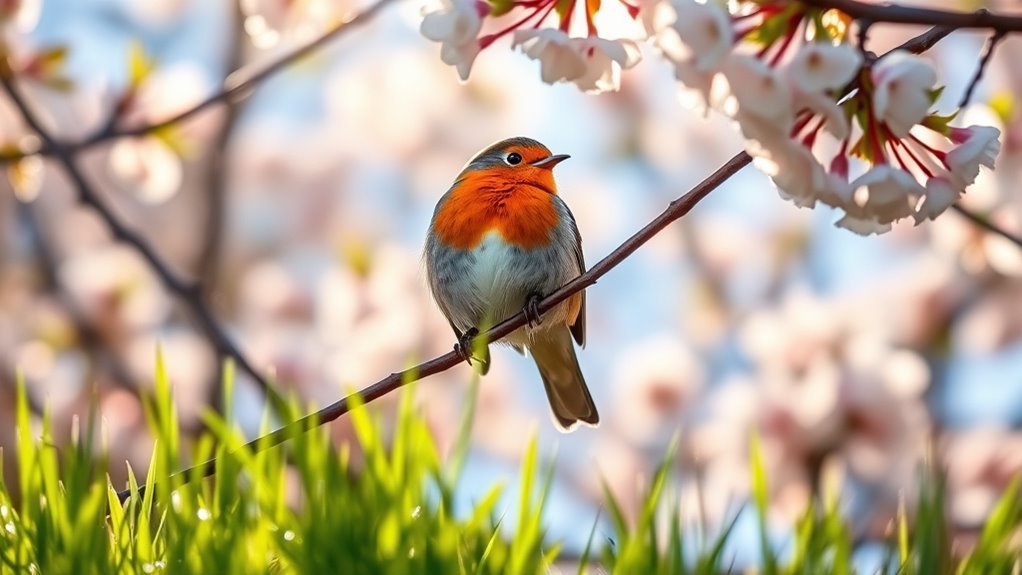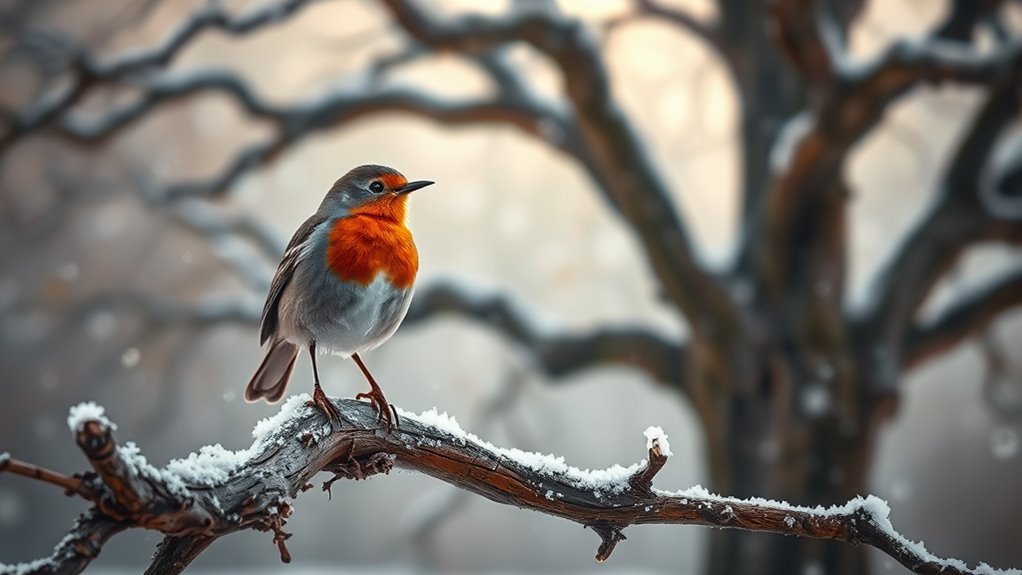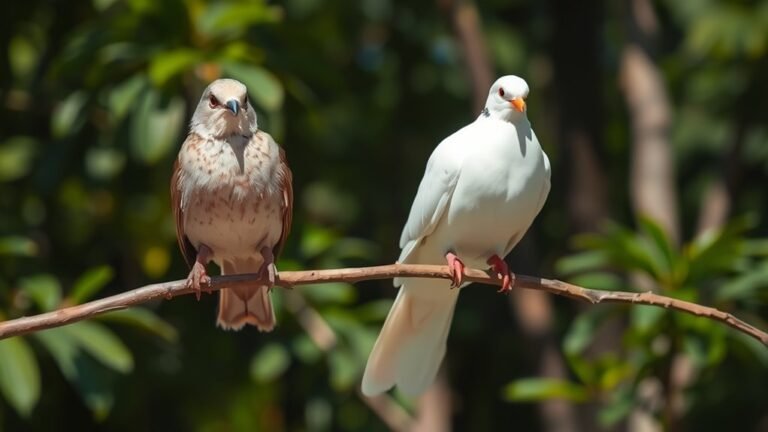The Legend Behind Robin Redbreast
The robin redbreast is easily recognized by its bright red chest as it moves through gardens and parks. This small bird is linked to a powerful legend from old stories and Christian beliefs. Each time we see a robin redbreast, we may wonder about its special meaning related to sacrifice and renewal. What makes this tiny bird resonate with us as we face life's challenges? The answers reveal themselves in surprising ways.
Key Takeaways
- The robin's red breast symbolizes warmth, hope, and renewal after winter, representing the sun rising after dark times.
- In Christian folklore, the robin's breast is said to be stained with Christ's blood, symbolizing sacrifice and redemption.
- Native American stories depict robins as adaptable creatures, embodying transformation and the spirit of resilience in nature.
- European myths regard robins as messengers between the physical and spiritual realms, underscoring their cultural significance.
- Conservation efforts today highlight the robin's charm, connecting people to nature and fostering community engagement for their survival.
The Origins of the Robin Redbreast in Folklore

The Robin Redbreast is a symbol of warmth and hope. It's often seen in gardens and woodlands.
In folklore, its bright red breast represents the sun rising after dark winters. Legend says the Robin's song brings joy and guides tired hearts home.
Stories describe the battle between the robin and winter's chill, illustrating nature's cycles. Spotting a robin connects you to stories of ancestors who valued this resilient bird and its bond with nature.
Enjoy the beauty and meaning of the Robin Redbreast in our world today.
Symbolism of the Robin in Various Cultures
Various cultures have seen the robin as a strong symbol. This bird often represents renewal and joy, especially in spring.
In Native American stories, robins are symbols of transformation and adaptability, showing resilience in change.
In European myths, robins act as messengers between humans and spirits, providing hope during hard times. Their cheerful song creates a sense of belonging and reminds us that nature is full of life and promise.
The appreciation of the robin across cultures highlights its importance and creates connections among different traditions.
The Connection Between Robins and Spring

As spring arrives, robins come out from their winter homes. Their presence marks the start of a lively season.
You notice the warmth in the air while watching these birds hop on the grass. Their cheerful songs mix with the sound of new leaves growing. Each robin symbolizes the joy and renewal of spring, a reminder that life returns after the cold months.
Their bright red breasts stand out against the fresh greens, encouraging you to appreciate the new beginnings around you. As nature thrives, your spirit also lifts.
Robins aren't just birds; they're a symbol of spring and shared moments. Enjoy observing them as they brighten the season.
Legends of the Robin in Christianity
Many birds fill the skies, but the robin is unique in Christian folklore. It symbolizes the life of Jesus. Legends say that a robin's red breast became stained with Christ's blood as it tried to remove a thorn from his brow during the crucifixion.
These stories offer a sense of divine protection and highlight themes of sacrifice and redemption. In Christian symbolism, the robin stands for new beginnings and hope. It reminds us of the promise of resurrection.
Watching this vibrant bird encourages reflection on life's challenges and fosters a sense of belonging within the Christian community. The robin's presence can inspire us to find deeper meaning in our struggles.
The Robin as a Harbinger of Good Luck

Seeing a robin in your garden often brings a sense of hope and joy.
Many people believe that spotting a robin indicates good luck and positive changes. The robin, with its bright feathers, symbolizes renewal and fortune.
- A robin can mean a new opportunity is on the horizon.
- Its presence may indicate the end of difficulties.
- In some cultures, robins are seen as messages from loved ones.
- Finding a robin feather may suggest a financial gain.
When you hear a robin's cheerful song, take a moment to appreciate the positivity it brings.
Allow the robin to guide you toward brighter days and new beginnings.
Tales of Transformation and Rebirth
Tales of transformation and rebirth often feature the robin, showcasing the beauty of change.
These stories highlight the robin's role in transformation, representing hope and renewal. When winter fades, the vibrant red breast of the robin appears, signaling the return of life.
You can sense the air shift as fresh dreams arise. Each chirp carries the promise of rebirth, encouraging you to accept your own changes.
When you connect with the robin, you feel a shared rhythm of renewal, reminding you that change is a chance to become who you truly are.
The Robin in Poetry and Literature
The robin is a common bird found in gardens and meadows. It often appears in poetry and literature, symbolizing renewal and hope. Poets create vivid scenes that highlight the warmth of spring and the idea of new beginnings. Their words evoke strong images that resonate with readers.
- The robin represents the cycle of life.
- It symbolizes resilience in tough times.
- Imagery related to the robin brings feelings of nostalgia and longing.
- The robin's song reminds us of brief moments of joy.
Reading about the robin connects you to nature. You find comfort in the natural rhythms of life that the robin represents.
The Role of the Robin in Children's Stories
In children's stories, the robin often serves as a friendly guide. This cheerful bird brings warmth and joy, making the tales relatable to young readers. You might see the robin perched on a tree branch, singing happy songs that encourage bravery or sharing forest secrets with curious kids.
With its bright red breast, the robin symbolizes friendship and adventure. As you read, it helps you explore ideas about home, belonging, and growth, making each journey feel possible. In these stories, the robin becomes more than just a character; it's a trusted friend, leading children on exciting adventures.
The Symbol of the Robin in Art
The robin has a bright red breast and a cheerful attitude. It has attracted the attention of artists and poets. The robin symbolizes renewal and hope. In art, the robin represents changing seasons and new beginnings.
Here are some common themes featuring the robin:
- Art often shows love and rebirth through the robin.
- Poems link the robin to feelings of nostalgia and safety.
- Various cultures depict the robin in their folklore.
- Nature scenes show the robin announcing the arrival of spring.
When you look at these artworks, the robin fosters a sense of connection. It brings together stories from different cultures, reminding us of the beauty and cycles of life.
Modern-Day Interpretations of the Robin
In modern cities, the robin stands out as a symbol of resilience. This bird shows nature's charm in busy urban areas. Its bright red breast adds color and happiness to our lives.
The robin appears in songs, books, and art, connecting us to nature. You can find robins in your neighborhood, reminding you of wildlife's presence. Each sighting creates a story and brings joy.
These moments encourage you to stop and enjoy the blend of nature and daily life, fostering a sense of community.
Conservation Efforts for Robin Redbreast Populations
Conservation efforts for robin redbreast populations are essential to keep these birds in our skies.
You can help ensure their future. Here's how you can participate:
- Plant native trees and shrubs in your garden to support their habitat.
- Join population monitoring programs to track robin numbers in your area.
- Work with local conservation groups to restore and protect vital habitats.
- Educate others about the role of robins in our ecosystem.
Every small action makes a difference.
Together, we can keep our skies full of these delightful birds!
Frequently Asked Questions
What Is the Average Lifespan of a Robin Redbreast?
The average lifespan of a robin redbreast is typically between two and five years. This varies due to factors such as food supply and the threat from predators. Watching these birds in gardens can spark curiosity about their lives and longevity.
Do Robin Redbreasts Migrate or Stay Year-Round?
Robin redbreasts show different migration habits. Some birds fly south for the winter, while others remain in their homes throughout the year. If you watch them closely, you will see how they adapt to the cold, bringing a sense of warmth to the winter months.
How Can I Attract Robins to My Garden?
To attract robins to your garden, use bird feeders filled with mealworms or fruit. Plant native flowers and shrubs to provide shelter. Add a birdbath for water. With these steps, you will invite robins to your garden, creating a lively and cheerful environment.
What Do Robin Redbreasts Eat in the Wild?
In the wild, robin redbreasts eat insects and berries. They enjoy insects for their crunchy texture. The birds also like berries, which provide sweet flavors. This feeding behavior adds vibrancy to gardens, creating an enjoyable atmosphere.
Are Robin Redbreasts Endangered or Threatened?
Robin redbreasts are not classified as endangered or threatened. Their populations are stable due to conservation efforts. You can continue to enjoy seeing them in gardens and parks.

Hello, I’m Emily Price, the founder of Birds Affection. As a passionate bird enthusiast and spiritual seeker, I’ve always been fascinated by the symbolic meanings and mystical connections between birds and our lives. On this website, I share my knowledge and insights on the spiritual significance of various bird species, exploring their roles as messengers, guides, and teachers. Through my writing, I aim to inspire and educate others on the profound wisdom and beauty that birds bring to our world. Join me on this journey as we delve into the enchanting realm of bird symbolism and discover the hidden meanings behind these magnificent creatures.







